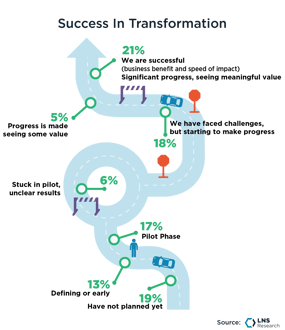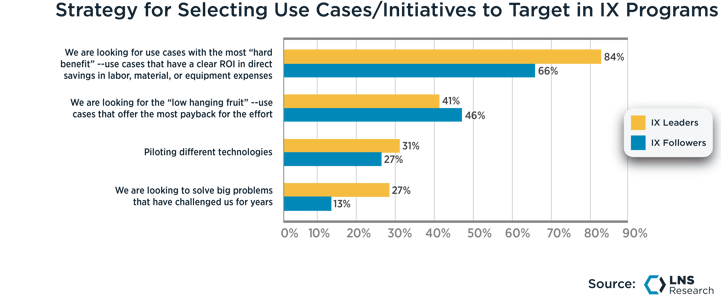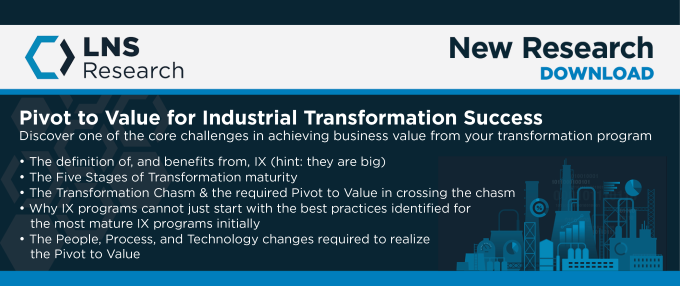There is an inherent dilemma in Industrial Transformation (IX). No one wants a massive, multi-year IT project, yet transformation, by definition, is looking for significant impacts and is, therefore, hard. Let’s look at the definition of IX, what makes it so difficult, and why incremental gains will likely not get you there. Finally, we will advocate for a 2-Step strategy – after the dance, of course – for the IX Program, including a look at a success story to illustrate that 2-Step.
Industrial Transformation (IX) Defined and Why it is So Hard
Industrial Transformation is the proactive and coordinated approach to leveraging
digital technologies to create step change improvement across the value chain. It goes by many names: Industrie 4.0, Digital, Connected, or Smart Manufacturing. IX is differentiated from Continuous Improvement programs such as Lean and/or World Class Manufacturing (WCM) by its focus on step change.
 Industrial Transformation has become a very real phenomenon across industrial operations, with more than two-thirds of companies committed to an Industrial Transformation program. Yet only a select few – the 20% of those companies engaged that we label as Industrial Transformation Leaders (IX Leaders) – are realizing significant benefits. As detailed in an LNS Research eBook, IX Leaders are dramatically improving the company's financial performance. Leaders are 72% more likely to have grown revenues by more than 10% and 57% more likely to have reduced the Cost of Goods Sold (COGS) by more than 10% as a result of their IX Program. All the while, the vast majority of programs have not yet realized any value.
Industrial Transformation has become a very real phenomenon across industrial operations, with more than two-thirds of companies committed to an Industrial Transformation program. Yet only a select few – the 20% of those companies engaged that we label as Industrial Transformation Leaders (IX Leaders) – are realizing significant benefits. As detailed in an LNS Research eBook, IX Leaders are dramatically improving the company's financial performance. Leaders are 72% more likely to have grown revenues by more than 10% and 57% more likely to have reduced the Cost of Goods Sold (COGS) by more than 10% as a result of their IX Program. All the while, the vast majority of programs have not yet realized any value.
Challenges in IX
So, what makes IX so hard? The answers are myriad, but LNS Research has identified a series of common challenges across a wide variety of operations:
-
-
-
IX is particularly challenging as solutions must be deployed across a manufacturing network that varies by manufacturing model, culture, Operational Technology (OT) deployed, and digital maturity.
-
Big Data, Artificial Intelligence (AI), and Machine Learning (ML) technologies are new to most corporations, so new talent has to be acquired.
-
Data Science is an emerging domain without a presence in most corporations.
-
The silos of IT and OT and their associated data prevent effective performance management/optimization.
-
Manufacturing is not as consistently automated or even “sensored,” with less than 43% of required plant equipment connected at all.
The benefits are big, and the challenges are real. So, one would expect that organizations would be “all in” on IX. But that is simply not the case. Budgets are relatively small and focused primarily on pilots or proofs-of-concept. Teams are often small and comprised mainly of corporate personnel to keep others focused on their day jobs.
More importantly, “big bang” projects starting with giant visioning sessions and extending through multi-year rollouts are unacceptable in today’s corporate world. ERP rollouts that took years, hundreds of millions in capital, and the focus of the company’s best IT resources have soured most companies on large/massive scale technology projects (even if, in the end, those rollouts were largely successful). Even digital technology vendors are advocating quick ROI projects and simple implementation strategies. The only ones still advocating for large-scale projects appear to be management consultants and consulting companies.
The typical solution is an incremental strategy to create “step change” (the obfuscation is deliberate). LNS Research regularly hears that companies intend to achieve their 10% “step change” goal through ten 1% improvements. Not only does that confuse IX with continuous improvement, but the evidence clearly shows that incremental “dip your toe in the water” strategies quickly stagnate. Project after project, program after program, fail to scale and does not achieve meaningful business value. Others see this as “pilot purgatory.” We see it as “Transformation Purgatory.”
Incremental Plans Stagnate as they hit the Transformation Chasm
Evidence increasingly shows that IX Programs – especially successful ones – must restructure their efforts mid-flight to achieve, sustain, and grow the return on investment (ROI) from their digital investments. At LNS Research, we call that program restructuring the “Pivot to Value” as meaningful improvement in the company's financial performance is dependent on these changes.
People, process, and technology Pivots are required, but one seems particularly relevant here - the need to move away from focusing on “quick wins” to solving big problems. Quick wins are critical to gain program momentum but may not always build the transformative capabilities needed for step change improvement. Manufacturers must think about all the hard work behind real transformation instead of focusing exclusively on the low-hanging fruit.

Manufacturers must build data infrastructure from sensor/machine to Data Lake, including data connectivity, transport, and contextualization. It seems obvious enough. We have all heard the slogans: “data is the new oil,” “data is the currency of transformation,” etc. To empower data to drive transformation, one must be able to get to it, transport it to where you need it, put it into context, and package it for effective consumption. The problem is there is no direct payback for that work. “Data plumbing” does not provide value, only the insights that come from that plumbing. In fact, business value is only derived from the actions taken from those insights.
At some point, IX Programs must focus on the data infrastructure. LNS Research believes this is a crucial Pivot required to deliver real and sustainable business benefits. IX Leaders are 83% more likely than Followers to invest in “infrastructure (data acquisition, cleansing, contextualization, etc.) without direct and immediate payback.”
One Key to Why a Large Pharmaceutical is Succeeding at IX
The proof is in the exemplars. A large pharmaceutical company’s executive and transformation leader recently presented at LNS Research’s The IX Event last October. He asserted that “Enlightened Leadership” by executive management at his company understood the potential of data and analytics in taking the company to the next level of performance. Executives gave the Digital Team the “time and space” to experiment and develop the approaches without pressure for return on investment (ROI) for the first year. This experimentation period allowed the Digital Team to experiment with ideas, fail at some, then regroup and try a different approach until they arrived at workable solutions. Coming out of that ROI-free investigation was what LNS Research would describe as a plan for a Data Hub architecture and a technology platform. Both were later critical to significant new product introduction success in developing and manufacturing new vaccines and treatments at scale. This focus on the data infrastructure without any direct payback was crucial to the company’s transformation success.
A 2-Step Dance is One Possible Strategy to Reconcile the Inherent Tensions
Not every company has the financial resources of this large pharmaceutical company. In fact, most do not. So, what can companies do to reconcile the need for the big effort and the desire for smaller initiatives? One potential answer is the 2-step in the early stages of IX. We will use the names of two stages to highlight the two steps. A good name for this 2-step dance might be: “Prove/Incubate” simultaneously!
-
-
-
Do focus on smaller goals with tight ROI expectations!%20Maturity%20Business%20Case%20and%20Objective%20Scope-4.png?width=3108&height=2488&name=Industrial%20Transformation%20(IX)%20Maturity%20Business%20Case%20and%20Objective%20Scope-4.png)
LNS Research has found that companies in the Incubate and Prove stages of transformation are better served by seeking solutions to departmental-level challenges and focusing on cost reduction. Keeping the program more focused and less invasive dramatically increases the probability of success in these early stages. The rewards are not as great, but the probability of success is significantly greater as the span of control is much smaller and benefits more tangible (cost reductions are more readily measured). These early, focused successes build the momentum around the IX Transformation Vision. Eventually, to cross the Transformation Chasm, IX Programs must change to focus on the larger organization, the value chain, and the top line, as reflected in the diagram below. In the first two stages of the program, a tight focus on smaller initiatives is the right strategy for the bulk of IX activity. The heavy lifting of pursuing value chain and cross-functional goals should be deferred until the later stages of transformation.
Accountability is critical. The key goal of these first two phases is momentum, so it is critical that specific operational metric and financial improvement goals be set, tracked, and appraised. Looking for “low-hanging fruit” is an effective way to kick off and build an IX Program, but only if the “fruit” ties to measurable operational improvements. Most projects should be measured not against technical benchmarks but against business benchmarks.
One specific technique that can accelerate benefit realization is to select “easy” use cases that also help build the infrastructure required over the long run. For example, machine connectivity can provide direct payback in terms of improved manufacturing efficiency and improved quality. It also is a key capability of the data infrastructure that needs to be architected and built – you have to be able to get to the data after all. LNS Research therefore believes it to be one of a number of use cases that can deliver very real return but also be a piece of the large data plumbing investment.
-
Establish a parallel track to “Lean in Early” by focusing on data infrastructure
We deliberately used the words “bulk” and “most” in the last section. The second part of the “2-step” is a parallel initiative to focus on the data infrastructure early.
LNS Research is on record advocating that companies “Lean in Early” on the Pivot to Value. Thinking about the long-term requirements of the program early in the program can have advantages. You can be doing several things in the Prove stage that help prepare you to cross the Transformation Chasm. Among the most impactful is getting a running start on the data infrastructure by doing a lot of the planning, mapping, and definitional work as soon as possible. Begin focusing on building the infrastructure work as soon as practical.
Unlike track one, this work cannot be tied tightly to business objectives and ROI. As we said, “data plumbing” has no direct return. It simply enables analytics, insights, decisions, and actions that drive transformation. It is why we have been using the words “infrastructure” and “plumbing.” Instead, this parallel work should be tightly prescribed with a clear architectural roadmap (we call it an Operational Architecture) and specific technology benchmarks.
It is critical for CEOs and CFOs to give their IX Program as much “time” and “space” to focus on data and data infrastructure as feasible. It may not be complete freedom, but some technology focus is appropriate. After all, the data clearly shows that “step change” business returns are realized only with a focus on these infrastructure issues.
So, the 2-step is to execute one track to prove the value of digital technologies while simultaneously incubating the long-term architecture—the Incubate and Prove stages of Transformation maturity.
Bottom line for Executives
No one should be surprised to find that the goals set, the metrics tracked, and the return expectations established by executive management are critical to transformation success. It may be surprising that focusing on both “quick wins” with tangible ROI and plumbing with no direct payback is crucial.
The art of the 2-Step is getting the balance right between these two tracks for your organization.
By the way, sorry for the corny line dance metaphor and for convoluting IX Stage names!

 Industrial Transformation has become a very real phenomenon across industrial operations, with more than two-thirds of companies committed to an Industrial Transformation program. Yet only a select few – the 20% of those companies engaged that we label as Industrial Transformation Leaders (IX Leaders) – are realizing significant benefits. As detailed in an
Industrial Transformation has become a very real phenomenon across industrial operations, with more than two-thirds of companies committed to an Industrial Transformation program. Yet only a select few – the 20% of those companies engaged that we label as Industrial Transformation Leaders (IX Leaders) – are realizing significant benefits. As detailed in an 
%20Maturity%20Business%20Case%20and%20Objective%20Scope-4.png?width=3108&height=2488&name=Industrial%20Transformation%20(IX)%20Maturity%20Business%20Case%20and%20Objective%20Scope-4.png)
